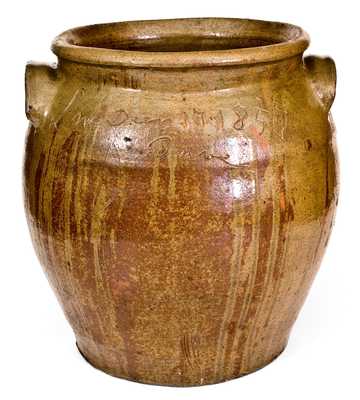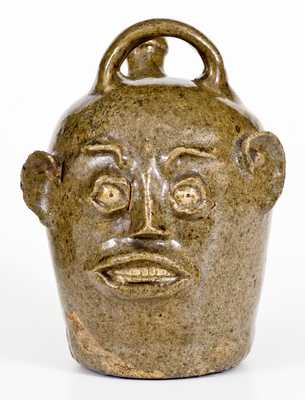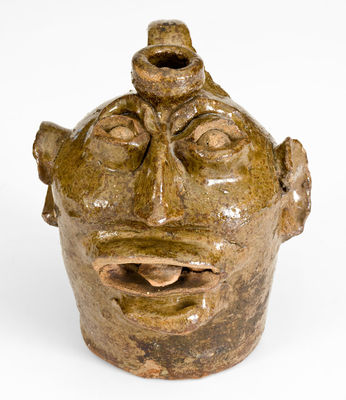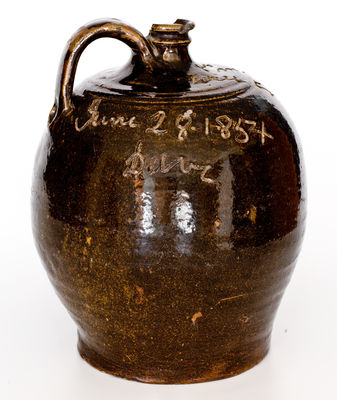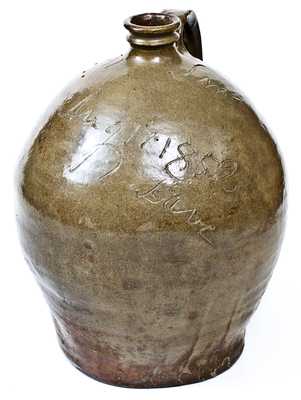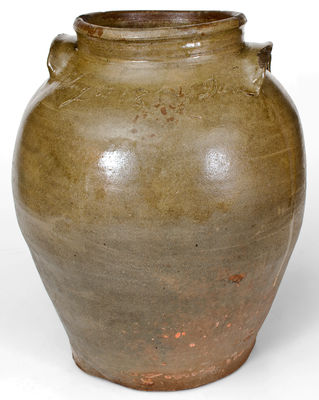Exceedingly Rare and Important Six-Gallon Alkaline-Glazed Stoneware Jar with Incised Owl Motif, Inscribed "Eagle toed owl," attributed to David Drake, Pottersville or Lewis Miles Stony Bluff Manufactory, Edgefield District, SC, circa 1830-1840, bulbous jar with broad rounded rim and arched lug handles, the surface covered in a gray-green alkaline glaze with lighter runs descending from the rim. Incised at the shoulder with the inscription, "Eagle toed owl," in the distinctive penmanship of enslaved African-American potter, David Drake. An accompanying deeply-incised drawing of an owl appears to the left of the inscription, depicting the bird with a long, hooked beak, dashed feather detail throughout the face and tail, and curved strokes along the body. Having recently surfaced in the Southeastern United States, this jar is perhaps the greatest discovery in Drake's work to come to light in the last decade or more, presenting the man as a three-fold artist: potter, poet, and, in this case, illustrator. The vessel's refined potting, light-colored glaze, and small-sized penmanship are indicative of earlier pieces by this potter. Possibly produced before Drake started to sign his work, or shortly into this period, the jar belongs to a small body of other unsigned inscribed pieces, among them the well-known "Catination" and "Concatination" jars, dating to the 1830s. A rarely-seen single, diagonally-incised slash mark on the reverse shoulder of the owl jar relates to a single incised cyma-curve on the reverse of Drake's "Catination" jar, dated 1834, suggesting an early date for the former. Author Leonard Todd, in his 2008 book, Carolina Clay, ambitiously took it upon himself to list every inscription known in Drake's work at that time. While Todd had amassed a list of thirty-five poems, a much smaller group of examples bearing shorter, non-poetic inscriptions were documented. Among these were pieces bearing slogans such as "cash wanted" or "not counted," the cryptic words "Catination" and "Concatination," and names of the vessels' owners. The "Eagle toed owl" jar expands on this list and furthers our understanding of Drake's relationship with his owners during that time period--either the brothers, Harvey and Reuben Drake, and Jasper Gibbs at Pottersville or Lewis Miles at Stony Bluff. If a Pottersville product, this vessel corroborates the theory presented by Goldberg and Witkowski in their Ceramics in America 2006 article, "Beneath his Magic Touch: The Dated Vessels of the African-American Slave Potter Dave," that Drake was not allowed to sign his ware at Pottersville. However, it does support the notion that he was permitted to make his identity and literacy known within limits--in this case, through a short inscription and corresponding drawing. Of great importance is this naive portrait of an owl. The idea that an enslaved individual would be allowed the time to leisurely draw in a manufactory setting is a remarkable one. Drake's familiarity with a stylus is obvious in the numerous vessels he produced bearing writing; however, drawings by this potter are nearly non-existent, with only a few apparently smaller images known. In our research, we have yet to uncover another well-documented drawn image--in clay, paint, pencil, or any other medium--by an enslaved African-American craftsman. Twentieth-century examples of figurative drawings by the former Alabamian slave, Bill Traylor, are perhaps the owl's closest connection known in the art world. Drake's avian illustration and its moniker--combining the eagle, an overtly American image of liberty and freedom, with an owl, viewed in African-American folklore as a harbinger of death--may have symbolic meaning. The "dualist" bird possibly serves as a metaphor for the state of the African-American--a life trapped between freedom and suffering, one of defeat at the hands of the American people (or toes of the American eagle, so to speak). As Drake drew from the Bible for his poem vessels produced in later years, he may be using similar symbology acquired from the Old Testament, where eagles are generally mentioned in relation to God's blessing and owls associated with affliction. To further add intrigue to the inscription, owl calls were used as a means of communication in the Underground Railroad system, most famously by Harriet Tubman, who, years after this jar was made, mastered the call of the barred owl to guide the enslaved to freedom. As theories abound on possible hidden meanings in Drake's musings, this wonderful jar will certainly be a frequently discussed object in ceramics and American decorative arts circles for years to come. The vessel's placement in the potter's formative years as a poet and display of his interest in figurative art add to the significance of an already important work. Provenance: Recently surfaced in the Southeastern United States. A thin 7" crack from rim on front, descending from a minor rim chip. A minor 1 1/4" horizontal surface line in rim on reverse. A 2 1/2" flake to proper left handle. A tiny flake to proper right handle with a minor 1 1/2" horizontal line extending through it along edge of handle. Small base chips. A thin diagonal 6" surface crack ascending from base on proper left side of jar, not visible on interior. Surface lines and minor glaze spalling to reverse near base, not visible on interior. Other typical, minor surface flaws. H 14 3/4".


















